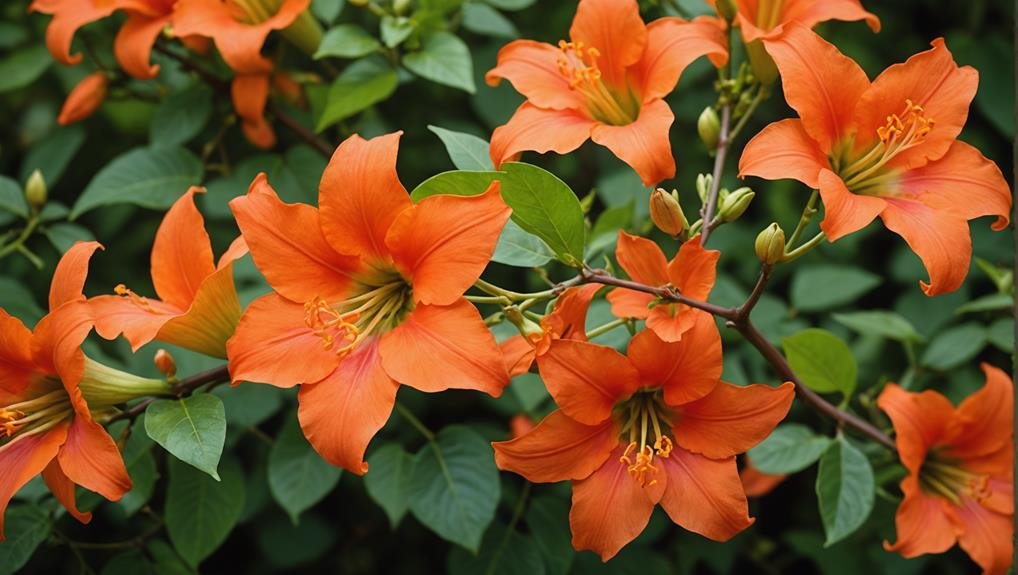Incorporating the Trumpet Vine into wedding floral arrangements offers a blend of aesthetic appeal and symbolic meaning that few other flowers can match. Known for its vibrant, trumpet-shaped blooms and vigorous growth, this vine not only symbolizes perseverance and good luck but also provides a unique, eye-catching element to any wedding decor. Whether used in bouquets, centerpieces, or as part of an arch, the Trumpet Vine adapts effortlessly to various themes and color schemes. As we explore its characteristics, cultural significance, and best uses, you will discover why it is a compelling choice for couples seeking to infuse their wedding with natural elegance and deeper symbolism.
Flower Overview

Providing a vibrant splash of color and attracting pollinators, trumpet vine (Campsis radicans) is a fast-growing, deciduous flowering vine known for its striking trumpet-shaped blooms. This native plant, also referred to as trumpet creeper, thrives in full sun and is well-regarded for its ability to infuse gardens with hues of red, orange, or yellow.
The trumpet vine flowers are particularly effective in drawing in hummingbirds and bees, making them a valuable addition to any garden designed with pollinator-friendly principles in mind.
Blooming from late spring to early fall, trumpet vine adds a dynamic and prolonged period of visual interest to outdoor spaces. Its vigorous growth habit requires sturdy support structures such as fences, trellises, or arbors to accommodate its climbing nature.
This vine is incredibly adaptable to various environmental conditions but performs best in full sun, which maximizes its blooming potential.
However, it is important to note that while trumpet vine is a native plant, it can become invasive if not properly managed. Regular pruning and containment are essential to prevent overgrowth and make certain that this beautiful plant contributes positively to the garden ecosystem without overwhelming other vegetation.
Physical Description
The trumpet vine (Campsis radicans) is distinguished by its vibrant trumpet-shaped flowers and compound leaves with ovate leaflets, creating a striking visual presence in any garden. This fast-growing, deciduous, woody plant can reach impressive heights of 30 to 40 feet, making it a prominent feature in any landscape. The entire plant is characterized by its sprawling growth habit, necessitating robust support structures such as fences or trellises to accommodate its vigor.
The compound leaves of the trumpet vine consist of several ovate leaflets, each with a pointed tip and serrated edges, providing a lush green backdrop to the vivid flowers. These flowers, shaped like trumpets, emerge in clusters, further enhancing the plant's ornamental appeal. After the flowering period, the plant produces elongated seed pods, adding another layer of texture and interest.
One notable aspect of the trumpet vine is its ability to anchor itself using aerial roots, which allow the entire plant to climb and cling to surfaces. While its aggressive growth habit can be visually striking, it's essential for gardeners to manage its potential invasiveness carefully.
Proper maintenance guarantees that the trumpet vine remains a captivating and controlled feature in any garden setting.
Available Colour Varieties

Beyond its striking physical characteristics, the trumpet vine offers a diverse palette of flower colors, enhancing its appeal for various aesthetic preferences. These vibrant hues make the trumpet vine a versatile choice for wedding arrangements, whether used in bouquets, centerpieces, or arch decorations.
Trumpet vine flowers are typically found in orange and red shades, but they also come in yellow, pink, and coral. Varieties such as 'Aurea' exhibit golden-yellow blooms, while 'Flamenco' displays vibrant red-orange flowers. Additionally, 'Grandiflora' trumpet vines feature larger, more showy flowers in shades of red and orange, making them particularly eye-catching in any floral design.
The following table illustrates the range of colors available:
| Variety | Color | Description |
|---|---|---|
| 'Aurea' | Golden-Yellow | Bright and cheerful, ideal for sunny themes |
| 'Flamenco' | Red-Orange | Vibrant and bold, perfect for striking accents |
| 'Grandiflora' | Red and Orange | Larger flowers for a dramatic effect |
| Mixed Shades | Yellow, Pink, Coral | Versatile options for various aesthetics |
People who live in regions where these vines thrive can readily incorporate them into their wedding florals. For more information or to discuss specific varieties, feel free to reach out via email address provided.
Latin Name and Taxonomy
Campsis radicans, commonly known as trumpet vine, belongs to the family Bignoniaceae and is a deciduous, flowering vine native to the southeastern United States. This plant is admired not only for its vibrant, trumpet-shaped flowers but also for its rapid growth and resilience. Within the taxonomic classification, trumpet vine is situated in the order Lamiales, which includes a variety of other ornamental plants.
The Bignoniaceae family, to which Campsis radicans belongs, is renowned for its diversity of visually striking and functionally versatile species. Here are some key points to help visualize its classification:
- Family (Bignoniaceae): Characterized by flowering plants, often with trumpet-shaped blooms.
- Genus (Campsis): Includes two main species—Campsis radicans (trumpet vine) and Campsis grandiflora (Chinese trumpet vine).
- Species (Campsis radicans): Known for its bright orange-red flowers and ability to attract hummingbirds.
- Order (Lamiales): Encompasses a wide range of plants, including both ornamental and medicinal varieties.
Understanding the taxonomic classification of trumpet vine, from its family Bignoniaceae to its specific species, provides a clearer picture of its botanical characteristics and ecological significance. This knowledge can be particularly useful when selecting plants for ornamental purposes or ecological restoration projects.
Geographical Origins

Native to the southeastern United States and Mexico, trumpet vine, also known as Campsis radicans, thrives in warm climates and diverse soil types. This resilient plant is commonly found in states such as Florida, Texas, and Georgia, where the conditions are ideal for its growth.
Beyond its native range, trumpet vine has demonstrated remarkable adaptability, naturalizing in various parts of Europe and Asia. This global distribution showcases the plant's ability to acclimate to different environments, making it a favorite in horticultural uses worldwide.
However, the very traits that contribute to its widespread appeal also pose challenges. In certain regions, trumpet vine is considered an invasive species due to its aggressive growth and potential to outcompete native flora. This has raised ecological concerns, particularly in non-native areas where it can disrupt local ecosystems.
Season Availability
Trumpet vine flowers are mainly available from late spring to early summer, making them an excellent choice for seasonal wedding arrangements. The blooming period typically aligns with peak wedding season, providing a fresh and vibrant option for various wedding themes. Their availability during these warmer months ensures that brides and event planners can integrate them seamlessly into their floral arrangements and seasonal decor.
The versatility of trumpet vine flowers allows them to be used in a variety of wedding elements. Consider the following options:
- Bridal Bouquets: The bold orange or red hues of trumpet vine flowers can create stunning focal points in bridal bouquets, complementing a range of color palettes.
- Centerpieces: Use trumpet vine blooms to add a touch of natural elegance to reception tables, enhancing the overall aesthetic of the event.
- Floral Installations: Incorporate these flowers into larger installations, such as arches or backdrops, to create a memorable visual impact.
- Seasonal Decor: Their availability during late spring and early summer makes trumpet vine an ideal choice for aligning wedding decor with the season's natural beauty.
Growing Conditions

Optimal growth for trumpet vine necessitates specific conditions that cater to its preference for arid climates and well-draining soil. This sturdy climber thrives in regions with low rainfall, making it an excellent choice for areas prone to dry conditions.
Properly meeting the soil requirements is essential; trumpet vine flourishes in well-draining soil, which prevents waterlogging and root rot.
In terms of sunlight exposure, trumpet vine can adapt to part shade but truly excels in full sun, where it can maximize its blooming potential. Support structures such as fences or trellises are necessary for this vigorous grower, as they provide the required framework for the vine to climb and spread.
Effective growth management involves a carefully planned watering schedule, ensuring the plant receives water only when needed, thereby avoiding overwatering. Moreover, trumpet vine does not require excessive fertilization, which can lead to uncontrolled growth.
Pruning techniques are crucial to maintaining the plant's shape and preventing it from overtaking the garden. Prune aggressively to remove overgrown sections and manage its spread, ensuring a controlled and aesthetically pleasing appearance. Regular pruning also encourages healthy blooms by redirecting the plant's energy towards flower production.
Cultural Significance
The vibrant flowers of the trumpet vine hold significant cultural symbolism, representing perseverance and determination in wedding arrangements. These characteristics are particularly cherished in matrimonial contexts, where they symbolize the enduring nature and growth potential of a marriage.
The trumpet vine's rapid growth and climbing nature metaphorically reflect the strong foundation and continuous journey of a couple's life together.
In various cultures, the trumpet vine is imbued with superstitions and beliefs that further enhance its appeal in wedding ceremonies. It is commonly associated with good luck and prosperity, making it a popular choice for those wishing to invite positive energies into their marital union.
Historically, the trumpet vine has been used in numerous traditions, often symbolizing the natural beauty and resilience required in sustaining lifelong commitments.
To bring this symbolism to life in your wedding, consider the following:
- Bouquets: Integrate trumpet vine blooms to add vibrant color and symbolic meanings of perseverance.
- Centerpieces: Use lush foliage to enhance table arrangements, reflecting growth and prosperity.
- Arches: Create elegant arches that symbolize the couple's journey and strong foundation.
- Decorative Elements: Incorporate trumpet vines in various decorative elements to infuse the ceremony with romantic and whimsical attributes.
These elements collectively contribute to a visually stunning and meaningful celebration.
Typical Use in Weddings

Incorporating trumpet vine into wedding decor offers a unique and visually striking floral element that enhances the celebration's overall aesthetic. The trumpet-shaped flowers of this vine add a whimsical and romantic touch, making them an excellent choice for unique arrangements and bridal bouquets. Their vibrant orange or red hues can harmonize beautifully with a wide array of wedding color schemes, allowing for versatile design possibilities.
As decor accents, trumpet vines can be used to create stunning centerpieces that serve as focal points during the reception. Additionally, they can be fashioned into garlands or arches, providing a lush, organic feel that is both elegant and natural. These elements can be particularly effective as a ceremony backdrop, lending a sense of enchantment and grandeur to the wedding vows.
For outdoor weddings, floral installations featuring trumpet vine can enhance the natural surroundings, blending seamlessly with the environment. These installations can range from simple arrangements to more elaborate designs, depending on the couple's vision.
Alternative Flower Types
Exploring alternative flower types such as clematis and climbing hydrangea can introduce diverse textures and colors to wedding floral arrangements. These alternatives offer unique arrangements that can complement the trumpet vine or stand alone as striking bouquet alternatives.
Clematis, known for its wide variety of colors and shapes, provides an excellent opportunity for creative pairings in wedding designs. Its vibrant hues and intricate petals can add a touch of whimsy and elegance to any arrangement.
Climbing hydrangea, on the other hand, brings a more subtle and refined elegance. Its delicate blooms and lush foliage can be used to create sophisticated and timeless arrangements that enhance the overall aesthetic of a wedding setting.
Consider the following ideas for incorporating clematis and climbing hydrangea into wedding floral designs:
- Clematis and Trumpet Vine Arch: Combine clematis and trumpet vine to create a visually stunning archway, perfect for wedding ceremonies.
- Climbing Hydrangea Centerpieces: Use climbing hydrangea in table centerpieces to add a touch of elegance and texture.
- Clematis Bridal Bouquet: Opt for a clematis-dominated bouquet for a unique and colorful alternative to traditional bridal flowers.
- Mixed Flower Garlands: Create garlands combining climbing hydrangea and trumpet vine for a lush and elegant décor element.
These alternative flower types offer endless possibilities for unique and memorable wedding floral arrangements.
